Third Annual Vintage CL Combat Fly-In
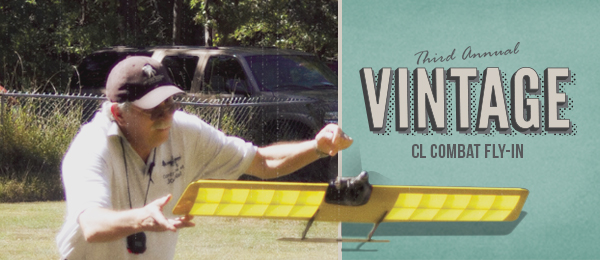
Written by Bob Hunt Period-accurate CL Combat models gather in New Jersey Event coverage Photos by the author As seen in the March 2016 issue of Model Aviation.
If you were to study the top competitive models in any modeling discipline, you’d discover that they were developed and honed over the years to be finely tuned instruments that are capable of producing amazing performances. You’d also probably note that most of the designs for a specific discipline are similar in appearance. Long-term, focused development of any type of model generally yields a homogenous result. In other words—what works, works! If you look back to the early days of development of a specific model type, you’d see that many avenues were tried in an effort to improve the breed. Some of the early ideas had merit and worked well, and some were blatant failures, but at each stage of development, the good traits were incorporated into the next generation’s designs, while less successful ideas were discarded. Still, it was just that “cut and try” process that produced some memorable model designs. Early design pioneers had no hard-and-fast rules, they simply tried whatever came into their minds. The result was a generation or two of original-looking, memorable designs. This process is most evident in early Control Line (CL) Combat model development. From the early 1950s through the late 1960s, there was a bonanza of original-looking models. Interestingly, many of the design aspects of certain early Combat models are identifiable in some of today’s advanced competition aircraft. In 2013, two lifetime CL enthusiasts from New Jersey, Tom Hampshire and Tom Schafer, decided to organize a Vintage CL Combat fun-fly event. Their hope was to attract six or eight local fliers and have them show up with their favorite Vintage Combat models. Well, they attracted 50 fliers and models that first year! The event was a joint venture of the Garden State Circle Burners (GSCB) CL club and the Middlesex Modelers. It was held at the GSCB club’s field in Lincoln Park, New Jersey. The event was so successful that they held another equally successful fly-in in 2014 and a third in 2015. On September 20, the 2015 version of the Vintage Combat Fly-In, directed by Tom Schafer, drew approximately 50 participants—spectators and fliers—with one coming from Oklahoma to attend. Andre Ming had read about the fly-in on the Stunt Hangar Internet forum and decided that he had to make the trip! There were more than 50 models on the field last year, and they ran the gamut from a 1952 vintage Ringmaster to early 1970s twin-boom aircraft.
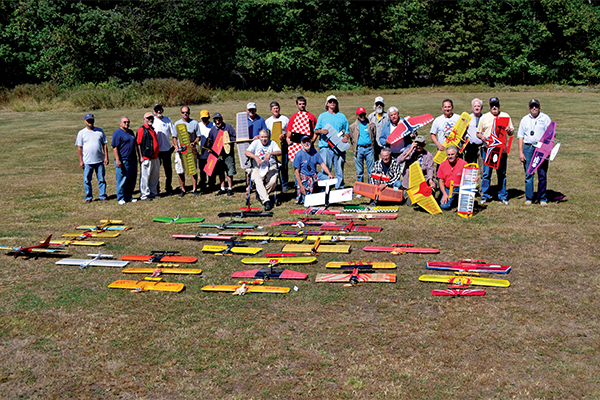
Here are a few of the many participants and models seen at the third annual Vintage Combat Fly-In. The event is cosponsored by the GSCB and the Middlesex Modelers, and was held at the GSCB field in Lincoln Park NJ.
The whole idea of this event is to come with your favorite-design Combat model and enjoy flying, exhibiting, or simply visiting. There were no matches scheduled, although a few impromptu ones were flown on the back circle at the GSCB field with no casualties. One fun event at the fly-in was the Larry Scarinzi Top Speed Challenge. Larry is known for his many exceedingly fast CL Combat models (see the sidebar), and sponsors an unofficial top speed event at the fly-in. The prize is an autographed picture of Larry holding his famous Super Satan. The 2015 winner was Tom Schafer. Tom flew his Riley Wooten-designed VooDoo that is powered by a Fox .36X BB and fitted with a custom-made Brian Gardner ABC piston and liner set. Tom posted a speed of 125 mph for the win. Close behind at 123.5 mph was Al Ferraro flying his Larry Scarinzi-designed Super Satan, featuring the same motor setup as Tom’s winning entry. Placing third was Jim Vigani. Jim flew his original-design Double Diamond to a credible 118 mph. Jim must have had too much fuel in his aircraft because after it was officially timed, it kept running for what seemed like several minutes. He managed to keep it flying until the engine quit, but I’ll bet he never again puts that much fuel in it! There were many Larry Scarinzi designs at the fly-in. I counted no fewer than nine Killers, five Super Satans, two Greased Lightnings, and one each of Larry’s Lethal Blast, Blitz, Sting Ray, Giant Killer, and Werewolf designs. There were also two Bill Netzeband-designed Half Fast flying wings, a Consolidated Wow, a Sterling T-Square, several Riley Wooten-designed Sneakers, VooDoos, Demons, a Top Flite Combat Streak, a Terry Prather-designed Winder, a Veco Renegade, a Sterling Super Swoop, a Midwest Hornet, a Scrambler, and even a magnesium belly-pan-equipped Count Clipper! I’m sure I might have missed a couple of airplane names, but each era was well represented. Most of the airplanes at the fly-in featured period-accurate engines, construction techniques, materials, covering, and finish (although a few were covered with modern shrink-film material). There were a number of outstanding transparent, silk-covered models that were beautiful to look at.
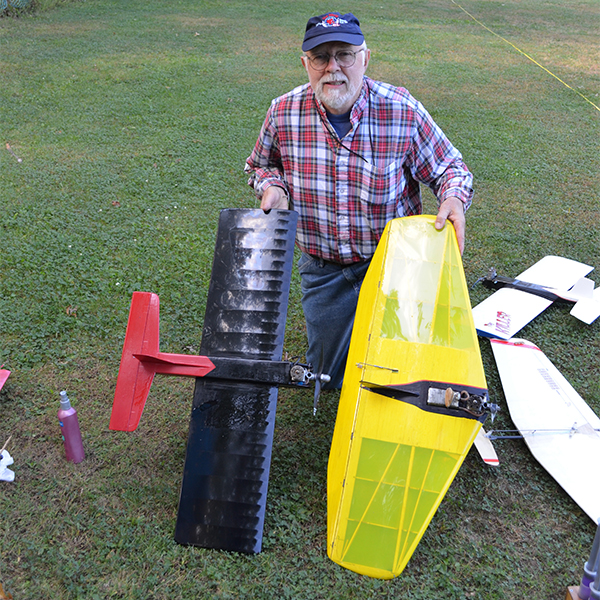
Tom Schafer is seen here with his Larry Scarinzi-designed Killer and his Bill Netzeband-designed Half Fast flying wing. The Half Fast was timed at 103 mph. That’s not bad for this period-accurate, 1958 Fox Combat Special-powered model!
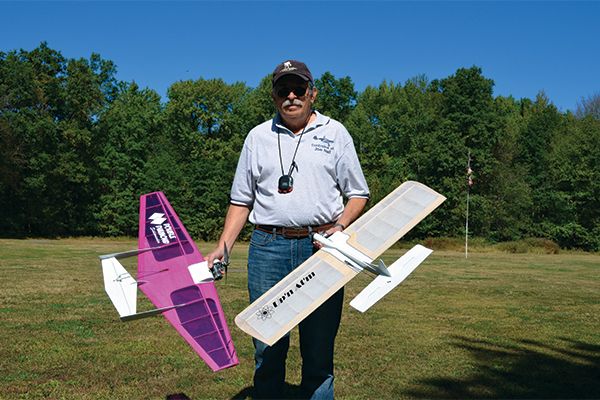
Jim Vigani designed these two CL Combat models: the 1961 vintage Double Diamond (L) and the 1962 vintage Up’n At’m. Jim placed third in the Larry Scarinzi Speed Challenge with the Double Diamond.
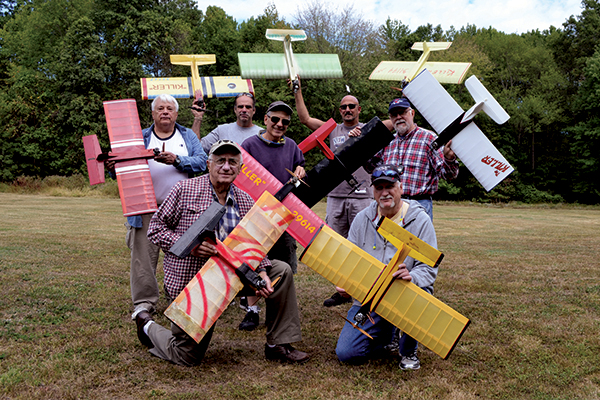
There were nine Larry Scarinzi-designed Killers at the fun-fly. They belonged to (clockwise from L) Tom Hampshire, Tom Luciano, Paul Rizkalla, Tom Schafer, Andre Ming, Larry Scarinzi, and in the center of this circle, Frank Imbriaco.
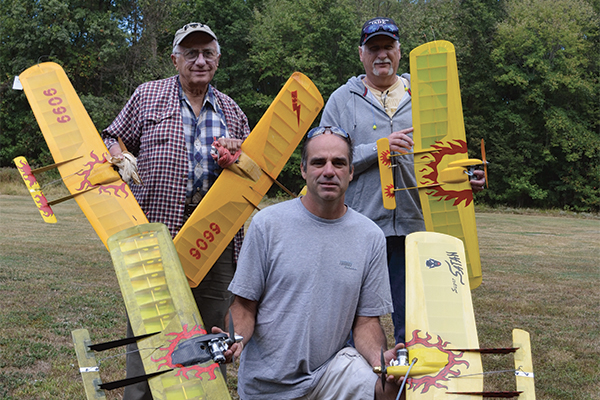
Here’s a gaggle of Super Satans. In the back row are the designer, Larry Scarinzi (L), and Andre Ming. Tom Luciano, kneeling, displays a tapered-wing Super Satan and a straight-wing version.
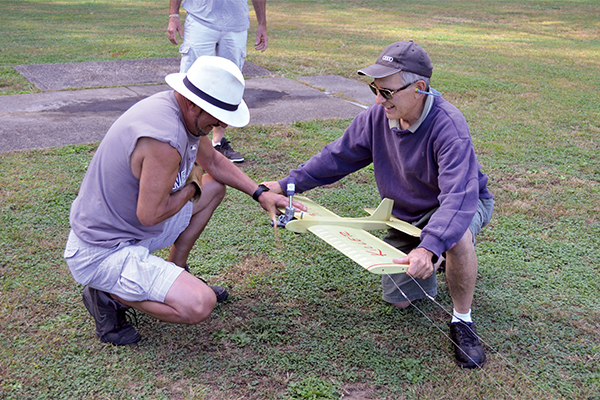
Paul Rizkalla (L) fires up the Fox .36X in his Larry Scarinzi-designed Killer, while Frank Imbraco holds the aircraft and prepares to launch. This design was published in the August 1958 issue of Flying Models.
GSCB club president, Ron Testa, made a pizza run at noon so that no one had to leave the fun at the field to get lunch. The hosting GSCB club members went out of their way to ensure that everyone had a great time. And, from all accounts, this was another successful fly-in. I received the following note from Tom Hampshire about the Vintage Combat Fly-In: “I have been active in Control Line for about 30 years in New Jersey and Pennsylvania. I thought I pretty much knew everybody who flew CL in this area, but now I find out that’s not the case. About five or six guys that I had never met or even heard of showed up at the fly-in, and they were really knowledgeable about the hobby/sport. They appeared to really enjoy themselves. I was very pleasantly surprised. “I’d suggest that other regions try this as a way to maybe draw a retread or two out of retirement. It’s a fun day, and unlike a serious contest, the work in putting one on pretty much ends with getting the sanction.” Join the fun this year. The date for the 2016 Vintage Combat Fly-In has not been set, but you can check the “Contest Calendar” in Model Aviation for that later on this year. The fly-in is typically scheduled for mid-to-late September. This report is humbly and gratefully dedicated to that great CL Combat flier and Model Aviation columnist, Rich Lopez. Rich’s passing has left a void in the CL Combat world and in the modeling community that can never be filled. Godspeed, Rich. The matches in heaven just got tougher. —Bob Hunt [email protected]
Larry Scarinzi: a CL Icon
For those who are not aware of CL lore, Larry Scarinzi is one of the most prolific designer/builders of top competition Combat and Aerobatics (Stunt) designs in what we now refer to as the Vintage era. Larry produced at least seven notable Combat models that were either published in major modeling magazines or kitted by major manufacturers. He also designed several experimental models that were not published and/or kitted, but had an impact on future Combat model design philosophy. Larry’s first original-design competition Combat model was the Lethal Blast, and it set standards on the East Coast for speed and maneuverability. It featured a thin, constant-chord wing and a long fuselage. A K&B Torpedo Green Head .35 powered that aircraft as well as his next design, the Greased Lighting.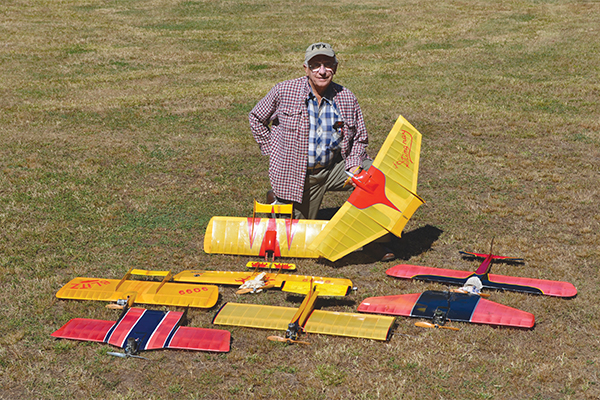
AMA Model Aviation Hall of Fame member and East Coast modeling icon, Larry Scarinzi, poses with a few of his many CL Combat designs. He’s been at it since the late 1940s, and is still going strong at 82 years young.
Larry admitted that he “borrowed” some of the design parameters for the Greased Lighting from Harold “Red” Rinehardt’s unique Stunt Wing—a model with which Red won the Stunt event at the 1954 New York Mirror Meet. If you were to compare the overall layout of Larry’s “Greaser” (as it is known in New Jersey) to the modern FAI Combat aircraft of today, you’d be amazed at how similar they are in design. Were Red and Larry really that far ahead of the crowd? Many of us who knew Red, and know Larry still, certainly think so. Other notable models designed by Larry include the Killer, Giant Killer, Junior Streak, Werewolf, Hatchet, Blitz, and Super Satan. Larry developed engines that produced amazing amounts of power, and with his Blitz and Super Satan series he routinely reached speeds in excess of 120 mph! And, that was back in the 1960s … Larry is a master at the lost art of silk covering, and most of his Combat models have finishes that rival those on contest Stunt models. Most of Larry’s designs feature 1/2-inch square main spars that extend through the fuselage. The ribs are positioned on the main spar and glued. Without the strength of the silk covering, these wings would probably not hold up under the flight stresses imposed upon them. Larry’s models were engineered from the beginning to use the silk covering as a structural component. This is not surprising, considering that at one point in his life, Larry was a structural analyst for Lockheed! One of Larry’s most interesting designs is the Sting Ray, which featured a side-mounted engine fitted with a racing-style helmet cowl, and a swept-forward leading edge wing. This aircraft is reputed to have exceeded 120 mph, and it is still a beautiful airplane. Larry brought the Sting Ray, and examples of many of his other designs, to the Vintage Combat Fun-Fly. And, he still knows how to fly them at amazing speeds, even at 82 years young. Larry is truly a modeling icon! —Bob Hunt
Bonus photos
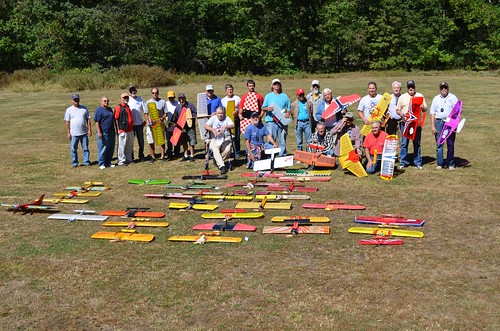










4 comments
1966 Nats
Combat Graffiti July 9th
Vintage Combat Fly-in
1950s combat
Add new comment